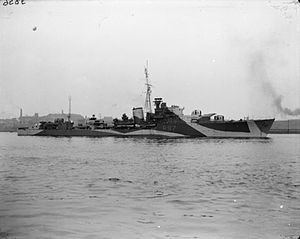Name HMS Grenville Commissioned 27 May 1943 Fate Scrapped 1983 Construction started 1 November 1941 Length 111 m | Laid down 1 November 1941 Identification pennant number F197 Launched 12 October 1942 | |
 | ||
HMS Grenville was the second ship of this name to serve with the Royal Navy in the Second World War. HMS Grenville and seven other U-class destroyers were ordered as part of the Emergency Programme. She was launched at Swan Hunter and Wigham Richardson Ltd., Wallsend-on-Tyne on 12 October 1942 and commissioned on 27 May 1943.
Contents
The Royal Navy's practice had been to name all destroyers of a class with names starting with the class letter, in this "U". However, the Royal Navy had reverted to an earlier practice of naming the flotilla leader after a prominent historical seaman, in this case after Vice Admiral Sir Richard Grenville, an Elizabethan soldier and sailor.
Second World War service
In late August 1943, Grenville and the Canadian destroyer Athabaskan formed the force covering anti-submarine sweeps by the Canadian 5th Support group, off north-west Spain. These ships were attacked by eighteen Dornier Do 217s using Henschel Hs293 A-1 glider bombs. Athabaskan was heavily damaged and the sloop Egret was sunk with the loss of 194 of her crew. After this, the U-boat hunt was abandoned.
Later on, in September and October, Grenville was involved in a series of blockade runner sweeps along the French coast (Operation Tunnel).
On 4 October, she joined in an action with enemy destroyers in which she was hit and suffered a small number of casualties. Later in October, during another of these sweeps, Grenville was with the cruiser Charybdis and other destroyers in another, more disastrous, Operation Tunnel action against a blockade runner off the north coast of Brittany. In this operation, the cruiser Charybdis and destroyer Limbourne were sunk by German Elbing-class torpedo boats.
In November, Grenville joined the 24th Destroyer Flotilla and the Mediterranean Fleet. In the Mediterranean, she supported the Anzio landings, sunk an E-boat and destroyed a train near San Giorgio on the Adriatic Sea.
On 3 December, she was ordered to refuel, arriving immediately after the air raid on Bari, a mustard gas disaster.
In May 1944, Grenville returned to Britain and in June took part in the landings in Normandy.
At the end of 1944, after a refit on the Humber, she left for the Indian Ocean where she joined operations against the Japanese. In January 1945, Grenville and three other U-class destroyers forming the 26th Destroyer Flotilla, escorted the British carrier force (Task Force 63) that became the British Pacific Fleet. After raids against Japanese installations on Sumatra, TF63 left for Okinawa, via Sydney, where there were air strikes on Japanese airfields in support of Operation Iceberg. Later, Grenville participated in the final raids on the Japanese home islands. Near the end of the Pacific war, several Allied warships began to relay Australian programmes to surrounding areas on shortwave. Grenville was one of these heard relaying the commercial programmes from 2KY Sydney in January 1946.
Post-war
Grenville served as part of the 25th Destroyer Flotilla in the Pacific and in 1946 and returned to Portsmouth where she was placed in reserve. In 1951 she served as part of the Plymouth Local Flotilla and was used as an air training target vessel in October 1951. She collided with the Italian ship Alceo, off Start Point, Devon. Three crewmen on the Grenville died and another four were listed as missing. After repairs she was re-commissioned at Devonport on 5 August 1952.
In 1953 - 54, she was extensively converted and re-armed into a Type 15 frigate. On 19 March 1954 she re-commissioned as leader of the 2nd Training Squadron, based at Portland. In 1957 she was fitted with an experimental helicopter landing pad for use during trials with the Fairey Ultra-light Helicopter. In December 1958 she replaced Torquay in the 5th Frigate Squadron. Between 1960 and 1964 she was held in reserve at Gibraltar.
In June 1966 she arrived back in Portsmouth under tow and was subsequently fitted with a third mast carrying experimental air-search radar, prior to its operational use in Invincible-class aircraft carriers. She attended Portsmouth Navy Days in 1967. In 1969 she replaced Wakeful in the 2nd Frigate Squadron.
In 1970 she was again present at Portsmouth Navy Days; at the time she was a trials ship for the Admiralty Surface Weapons Establishment (ASWE).
Grenville was paid off in 1974 and laid up in Portsmouth before being scrapped in 1983.
